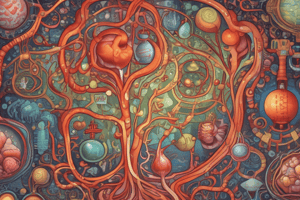Podcast
Questions and Answers
Which of the following are included in metabolism?
Which of the following are included in metabolism?
- Only breakdown of molecules
- Breakdown of organic molecules (correct)
- Only synthesis of molecules
- Synthesis of organic molecules (correct)
What are the two main factors that determine the outcome of a chemical reaction in a living cell?
What are the two main factors that determine the outcome of a chemical reaction in a living cell?
Direction and rate
What is true of exergonic reactions?
What is true of exergonic reactions?
Exergonic reactions are spontaneous and release energy during product formation.
According to the ____________ law of thermodynamics, entropy increases when energy is transferred from one form to another and some is lost as heat in the process.
According to the ____________ law of thermodynamics, entropy increases when energy is transferred from one form to another and some is lost as heat in the process.
Work in the cell can only be done with expenditure of _________________; it is defined as the capacity to do work.
Work in the cell can only be done with expenditure of _________________; it is defined as the capacity to do work.
Which of the following exhibit potential energy? (Select all that apply)
Which of the following exhibit potential energy? (Select all that apply)
How does the change in free energy differ between exergonic and endergonic reactions?
How does the change in free energy differ between exergonic and endergonic reactions?
What type of reactions results in products that contain less free energy than the reactants do?
What type of reactions results in products that contain less free energy than the reactants do?
What is enthalpy?
What is enthalpy?
In broad terms, energy can exist in two states:_______________ energy and _______________ energy.
In broad terms, energy can exist in two states:_______________ energy and _______________ energy.
Many of the chemical reactions that occur in cells are endergonic. These reactions are possible because they are coupled to:
Many of the chemical reactions that occur in cells are endergonic. These reactions are possible because they are coupled to:
Energy stored in the bonds of these molecules can drive cellular chemical reactions in certain directions.
Energy stored in the bonds of these molecules can drive cellular chemical reactions in certain directions.
All cells use a molecule called ________ to carry and release energy cyclically.
All cells use a molecule called ________ to carry and release energy cyclically.
When a physical system becomes more disordered, the entropy ______________.
When a physical system becomes more disordered, the entropy ______________.
The first law of thermodynamics is also known as the law of __________ of energy.
The first law of thermodynamics is also known as the law of __________ of energy.
In a reversible reaction, A + B ⇌ C + D are made, and depend upon:
In a reversible reaction, A + B ⇌ C + D are made, and depend upon:
The following are types of energy important to biological processes. (Select all that apply)
The following are types of energy important to biological processes. (Select all that apply)
When a water molecule is used to remove a phosphate group from ATP, this is called the _____________ of ATP.
When a water molecule is used to remove a phosphate group from ATP, this is called the _____________ of ATP.
What happens during phosphorylation involving glucose?
What happens during phosphorylation involving glucose?
What is the term used to describe the energy of a system that is available to do work?
What is the term used to describe the energy of a system that is available to do work?
A reaction is said to be _________ when the addition of free energy from the environment is required for the reaction to proceed.
A reaction is said to be _________ when the addition of free energy from the environment is required for the reaction to proceed.
The following describes the major difference between kinetic and potential energy.
The following describes the major difference between kinetic and potential energy.
When does chemical equilibrium occur?
When does chemical equilibrium occur?
What do the two laws of thermodynamics state?
What do the two laws of thermodynamics state?
The study of energy interconversions is called___________.
The study of energy interconversions is called___________.
If you stretch a rubber band, you will give it ______________ energy; and when the rubber band is released, it has _______ energy when it flies through the air.
If you stretch a rubber band, you will give it ______________ energy; and when the rubber band is released, it has _______ energy when it flies through the air.
Name the type of energy that is a form of potential energy stored in chemical bonds.
Name the type of energy that is a form of potential energy stored in chemical bonds.
What types of reactions occur spontaneously?
What types of reactions occur spontaneously?
Concerning Gibbs energy, ___________ reactions are spontaneous, and ________ reactions are not spontaneous.
Concerning Gibbs energy, ___________ reactions are spontaneous, and ________ reactions are not spontaneous.
When will an endergonic and exergonic reaction that are coupled proceed spontaneously?
When will an endergonic and exergonic reaction that are coupled proceed spontaneously?
The following cellular processes require a net input of energy. (Select all that apply)
The following cellular processes require a net input of energy. (Select all that apply)
Exergonic reactions have a _________ change in free energy, and endergonic reactions have a _________ change in free energy.
Exergonic reactions have a _________ change in free energy, and endergonic reactions have a _________ change in free energy.
During oxidative phosphorylation, a H+ gradient drives the production of ATP. What type of energy is stored in the H+ gradient?
During oxidative phosphorylation, a H+ gradient drives the production of ATP. What type of energy is stored in the H+ gradient?
What is proteome?
What is proteome?
All living things require which of the following, in order to carry out chemical reactions and thereby survive?
All living things require which of the following, in order to carry out chemical reactions and thereby survive?
What two assumptions do biologists use to determine values of equilibrium constants?
What two assumptions do biologists use to determine values of equilibrium constants?
Organisms couple ___________ and _____________ reactions because many vital cellular processes would not proceed without energy input.
Organisms couple ___________ and _____________ reactions because many vital cellular processes would not proceed without energy input.
What is an example of an object with high potential energy?
What is an example of an object with high potential energy?
The following are true according to the second law of thermodynamics.
The following are true according to the second law of thermodynamics.
Chemical reactions can proceed in both directions (reactants to products or products to reactants). Reactions with a positive change in free energy favor the formations of the _______________.
Chemical reactions can proceed in both directions (reactants to products or products to reactants). Reactions with a positive change in free energy favor the formations of the _______________.
In a generalized chemical reaction, the _________ constant is represented by K"eq".
In a generalized chemical reaction, the _________ constant is represented by K"eq".
What are the steps in the ATP cycle?
What are the steps in the ATP cycle?
What form of energy can be used to drive cellular processes such as muscle contraction and cellular movements?
What form of energy can be used to drive cellular processes such as muscle contraction and cellular movements?
What type of energy is stored in the covalent bonds of molecules? (Select all that apply)
What type of energy is stored in the covalent bonds of molecules? (Select all that apply)
How does the change in free energy differ between exergonic and endergonic reactions?
How does the change in free energy differ between exergonic and endergonic reactions?
Why is some energy unusable by living organisms?
Why is some energy unusable by living organisms?
The following statements describe the free energy (G) change of a spontaneous reaction.
The following statements describe the free energy (G) change of a spontaneous reaction.
The forward direction of the A + B -> C + D shows that ___________ are the products.
The forward direction of the A + B -> C + D shows that ___________ are the products.
Flashcards are hidden until you start studying
Study Notes
Metabolism and Energy
- Metabolism includes both the synthesis and breakdown of organic molecules.
- Direction and rate are the primary factors determining chemical reaction outcomes in living cells.
Exergonic and Endergonic Reactions
- Exergonic reactions are spontaneous and release energy during product formation.
- Exergonic reactions result in products with less free energy compared to reactants, characterized by a negative change in free energy.
- Endergonic reactions require energy input from the environment and have a positive change in free energy.
Thermodynamics
- The second law of thermodynamics states that entropy increases when energy is transferred from one form to another, often lost as heat.
- The first law of thermodynamics, known as the law of conservation of energy, asserts energy cannot be created or destroyed.
- The study of energy interconversions is termed thermodynamics.
Free Energy
- Free energy (G) is the energy available to do work in a system.
- A chemical reaction is spontaneous when there is a negative free energy change and the products have less free energy than the reactants.
- Gibbs energy determines spontaneity: exergonic reactions are spontaneous, while endergonic reactions are not.
Energy Forms and Storage
- Energy exists as kinetic (energy of motion) and potential (energy associated with position).
- Potential energy can be exemplified by objects like a stretched rubber band or water at the top of a dam.
- Chemical energy is a form of potential energy stored in molecular bonds, crucial for driving cellular reactions.
ATP and Cellular Energy
- ATP (Adenosine Triphosphate) is the primary energy carrier in cells, releasing energy through hydrolysis.
- Many cellular processes, including endergonic reactions and ATP synthesis, require a net input of energy, often coupled with exergonic reactions.
- The ATP cycle involves synthesizing ATP from energy released during catabolic reactions and breaking ATP down to release energy.
Chemical Equilibrium
- Chemical equilibrium occurs when the rate of formation of products equals the rate of formation of reactants, with the equilibrium constant represented by K"eq".
- Reactions with a positive change in free energy favor the formation of reactants.
Key Concepts
- Hydrolysis of ATP provides energy for various cellular processes, including phosphorylation of glucose.
- As disorder increases in a system, entropy increases, highlighting the efficiency loss in energy transformations.
- The balance between exergonic and endergonic reactions is critical for life processes, allowing cells to perform necessary functions.
Additional Facts
- Nature exhibits both reversible reactions and reactions that favor product formation based on energy input and concentrations.
- Equilibrium constants are obtained under the assumptions that water concentration and pH remain constant during reactions.
Studying That Suits You
Use AI to generate personalized quizzes and flashcards to suit your learning preferences.




